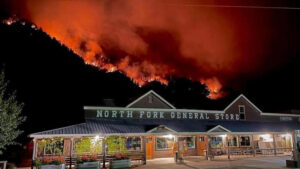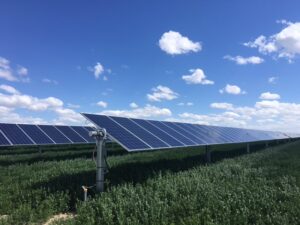The proposed Lava Ridge Wind Project
There’s been a lot of talk about wind energy since the Bureau of Land Management (BLM) released its draft Environmental Impacts Statement (EIS) on the proposed Lava Ridge Wind Project. We get it. There is a lot to digest. How will this impact the aquifer, roads on public lands, wildlife, cultural resources, and the viewshed for those within the area? ICL takes these concerns seriously, and is engaging accordingly. In all projects proposed on public lands, community concerns must be addressed from the start. It is especially important in this case, as there are a number of other renewable energy projects in the works in Idaho.
Just as vital as reviewing the potential impacts of these projects is recognizing that developing large-scale renewable energy projects is critical in addressing our climate crisis and protecting our quality of life. Appropriately sited projects will help lead Idaho and the Western U.S. on a path toward a clean energy future — as well as in addressing social justice issues where certain communities are directly impacted by fossil fuel pollution. ICL supports well-thought-out renewable energy projects, and based on the complexity of the Lava Ridge Wind Project, we are advocating for additional review and refinement if it is to be permitted.

Renewables in Idaho: The need is real
Climate change is real, humans are responsible, and the overall impacts to our communities are going to be severely disruptive. The McClure Center for Public Policy’s Climate-Economy Impacts Assessment dives into the Idaho-specific impacts of climate change. The report emphasizes that our snowpack is decreasing, and we know that is changing water availability for farmers and ranchers when they need water most. Habitat for sage-grouse is expected to shrink dramatically if we don’t take action. Along with wildlife, from farmers to firefighters, Idahoans are already suffering from the impacts of climate change. Now, we must mitigate the impacts.
To prevent the worst effects of climate change, we need to achieve a 50% reduction in U.S. greenhouse gas pollution from 2005 levels by 2030. We have less than 7 years to collectively achieve this target. What exactly this energy transition looks like remains an open question, but this much is clear: increasing energy efficiency and expanding small scale rooftop solar alone are not going to get us where we need to be. We also need to add large amounts of utility scale wind and solar energy. Such developments in the U.S. can not only help us move toward carbon neutrality, but also benefit individuals and communities in the short and long term (in construction, operations, maintenance, and manufacturing).
Idaho is already playing a role in this clean energy transition. Wind power generated about 16% of Idaho’s net electricity in 2021 which was provided by over 500 wind turbines at utility-scale wind facilities. According to the Governor’s Office of Energy and Mineral Resources, “Idaho’s wind production grew from 207,000 MWh at the end of 2008 to a total of more than 2,657,247 MWh in 2021.” But to tackle this global crisis, mitigate climate change impacts in Idaho, and become a more resilient state, we need to do more. We need to decrease our greenhouse gas (GHG) emissions. Clean energy will help get us there.

Why wind?
Nearly all credible decarbonization models incorporate large amounts of utility scale wind and solar energy. Wind and solar farms – paired with batteries – are cheaper, cleaner, and more reliable than volatile methane gas-powered plants and will help lead to a clean energy future.
Additional renewable energy projects will not only help mitigate carbon dioxide pollution that furthers climate change, which is currently causing droughts and water shortages throughout the region, but also generate new jobs and grow our economy in multiple ways.
Wind energy can help Idaho farmers and ranchers diversify sources of revenue – wind turbine leases (about 35 years long) provide landowners with additional annual income that helps make up for economic dips brought on by impacts from climate change (like increased droughts and floods) as well as the fluctuating price of the crops and livestock they produce.
Just like other products we export (potatoes, corn, wheat), clean energy generation in Idaho may produce more than we consume, and the excess can be sold. This energy can contribute to the Western Energy Imbalance Market (in which Idaho Power and Rocky Mountain Power both directly participate), which allows participants to buy and sell power, balancing supply and demand at a lower cost.
Idaho’s energy potential lies in our substantial renewable resources, including hydropower, wind, solar, biomass, and geothermal. While there is a lot of interest in (and debate about) nuclear energy, modular units are not deployable in the time period needed. Currently, wind is the number one type of renewable energy in the country. Many Idaho companies (i.e. Chobani, HP, Micron and Idaho Power) have made clean energy commitments and stand to support Idaho in clean energy independence; and ICL applauds these commitments. More and more companies are realizing that wind and other sources of renewable energy are the future, and the quicker we get on the right path to that future, the better off our communities will be. But, for future projects to be successful, local communities need to be involved early in the process.

The time is right
The time is right to expand Idaho’s clean energy portfolio with wind power. There is funding readily available for projects like these. The passage of the Inflation Reduction Act in 2022 finally helped even the playing field by lifting financial barriers for renewables so they can better compete with unsustainable fossil fuel sources, provide clean power, and meaningfully reduce carbon emissions. In an effort to help combat climate change and lower energy costs in Idaho, the U.S. Department of Agriculture (USDA) is providing funding through the Rural Energy for America Program for a dozen renewable energy projects. According to USDA Rural Development Idaho State Director Rudy Soto, “Unlocking these meaningful cost savings, made possible through energy efficiency improvements, is a force multiplier when it comes to helping businesses to thrive and grow.”
What’s next?
ICL is proud of its 50 years of work to protect the state’s landscapes, waters, and public lands, and we are steadfast in our commitment to protect those values. We also recognize that every aspect of our work is, and will increasingly be, affected by climate change. To protect our landscapes, people and ecosystems, we must also find suitable locations for wind and solar projects. Doubtless, siting renewable projects appropriately will be a huge challenge, so a growing part of our work is to find solutions that best respect and balance the wishes of local communities with our national need for clean power.
Our mission is to use our expertise and relationships with stakeholders and decision makers to promote equitable siting and responsible projects with community engagement from the start. As mentioned above, ICL is advocating for additional review and refinement of the Lava Wind Ridge Project and its impacts if it is to be permitted. We also encourage members of the public to review the BLM EIS regarding the Lava Ridge Wind Project and submit your own comments to the BLM here before April 20, 2023.
To stay updated on the progress of renewable energy in Idaho, sign up for ICL’s Climate Campaign email updates.

